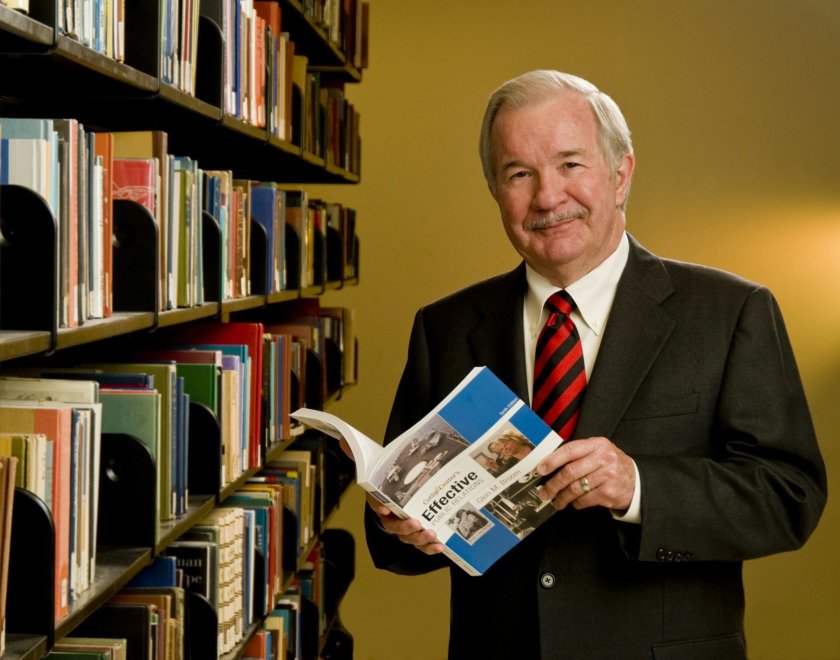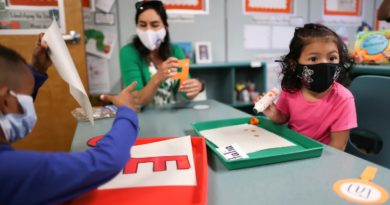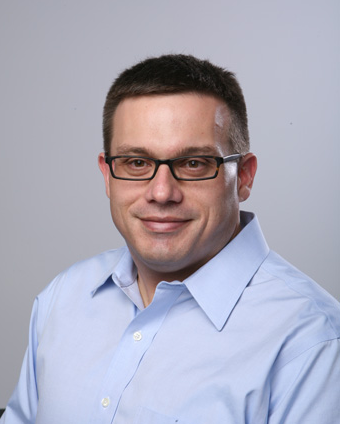Daily Business Report-Aug. 14, 2019
Microfibers fluorescing under a microscope. (Image courtesy of Scripps Institution of Oceanography)
Researchers adopt global approach
to identify ways to limit plastic pollution
Scientists at Scripps Institution of Oceanography are working to understand plastic degradation in the ocean, particularly smaller particles called microplastics and related microfibers.
Marine biologist Dimitri Deheyn, associate researcher at Scripps, is working on a two-fold approach to these micromaterials. He and postdoctoral researcher Sarah-Jeanne Royer are monitoring microfibers around the world to better understand how these fibers enter and spread in the environment, while also partnering with industry to identify possible avenues to limit plastic pollution and develop remediation strategies.
While cotton is a natural fiber, the majority of microfibers are synthetic and many are petroleum-based, making them a form of microplastic. Because of their ability to absorb larger amounts of water and unique chemical binding properties, they can be found in many textiles, including clothing and cleaning cloths, and are defined by their ultrafine nature (thinner than even a strand of silk). These fibers shed into the environment when textiles are washed and through everyday wear, and are becoming a growing concern among scientists and environmentalists.
Deheyn, an expert in biological light, color and toxicology, became interested in microfiber research after finding that these materials fluoresce under imaging conditions used in his lab. Deheyn uses change in color or light produced by organisms as an early indicator of stress (the same way people turn pale when starting to get sick), especially upon exposure to conventional pollutants like trace metals or environmental shifts related to climate change. In recent years Deheyn has noticed an increasing number of glowing fibers in his images.
“When I saw these fibers glowing in fluorescence in my samples, my first reaction was to clean the lenses of my microscope, but I realized that these fibers were actually part of my sample,” said Deheyn.
________________________

Glen Broom, influential PR
professor and author, dies at 78
San Diego Union-Tribune
In many government agencies and corporate board rooms, public relations used to be an after-thought, called into action only when something went wrong. Glen Broom helped change that. Through his work as a professor and administrator at San Diego State University, and through his co-authorship of a textbook that has been the industry’s bible for almost 70 years, Broom ushered PR from the realm of press releases into the daily decision-making of companies, the military, non-profits and other institutions.
“We are going from what we should say to what we should do,” he once told the Union-Tribune. Broom died Thursday from a heart attack while vacationing in Colorado. He was 78.
________________________
Did California State University ‘hide’ $1.5 billion?

California State University Chancellor Tim White promised Monday that he’ll share more information about CSU finances even as he criticized as “sensationalized” an audit that found the university squirreled away $1.5 billion.
White told a joint legislative audit committee he will follow the audit’s recommendations but said: “The CSU did not and does not hide money.”
In June, State Auditor Elaine Howle said CSU failed to disclose the $1.5 billion during budget talks. CSU officials say the money was earmarked for capital projects, to pay short-term debts, and for a rainy day.
Howle told legislators she found no evidence that CSU broke any laws. But she said student leaders were unaware that the surplus grew by $65 million in 2017 when the university hiked tuition.
CSU’s employee union members packed the hearing room. Staff weathered cutbacks during the recession and sought the audit.
________________________

Classes begin Aug. 19 for 53,000 students
at San Diego City, Mesa and Miramar Colleges
An abundance of new certificate and degree programs from cybersecurity to fermentation management, new centers for veterans and foster youth, and an expanding, tuition-free San Diego Promise await an estimated 53,000 students at San Diego City, Mesa, and Miramar colleges when the new academic year begins Aug. 19. San Diego Continuing Education, which provides everything from free career training programs to ESL and citizenship classes, begins its new academic year Sept.3.

Among this year’s highlights is the SDCCD’s rapidly expanding San Diego Promise, which waives tuition for all first-time, full-time students while providing the support and services they need to succeed. Approximately 3,100 San Diego Promise students are expected this year, a 55 percent increase over the 2018-19 academic year, when about 2,000 enrolled.
Click here for a listing of the new programs.
________________________
Westcore Properties sells large industrial portfolio
San Diego-based Westcore Properties has sold a 6,350,000-square-foot, Class A industrial property portfolio to San Francisco-based Stockbridge Capital Group for an undisclosed sum. Two properties are in San Diego County. With 26 assets across nine markets in five states, the portfolio is nearly 100 percent leased, despite many of the properties being vacant at the time of Westcore’s purchase. Westcore acquired all of the properties in the portfolio since September 2016 and renovated nearly all of them. The buildings’ tenants are primarily big-box and last-mile users.
The sale included San Diego County properties at 133 & 155 Mata Way, San Marcos, and 500-938 S. Andreasen Drive, Escondido.
________________________
Bungled multimillion-dollar roofing project
at SDSU a ‘case study’ on what not to do
Bella Ross | inewsource.org
Faced with a deadline to finish $2.5 million in renovations to a San Diego State University building or risk losing most of the funds, campus officials made a series of decisions that threatened the health of students, faculty and staff, records obtained by inewsource show.
A roofing material used in the construction sickened dozens of people andeventually led officials to close the Professional Studies and Fine Arts building in mid-March after weeks of complaints about noxious odors that enveloped classrooms, offices and hallways. Hundreds of classes were held in the building before it was vacated.
________________________

County transit agencies select Conduent
to provide new fleet management technology
Under a new contract, Conduent Transportation will upgrade hardward and software for the management system on board hundreds of buses for the San Diego Metropolitan Transit System and North County Transit District.
The agencies will utilize Conduent’s computer-aided dispatch/automatic vehicle location (CAD/AVL) solution to assist drivers with routing and keep buses on schedule, as well as provide real-time vehicle information on bus locations for passengers to make informed decisions. For dispatch personnel, the systems track the performance of the buses and enable effective communications with the fleet.
In San Diego, the upgrades will be performed on 375 buses operated by MTS and another 155 buses operated by NCTD. The work will entail the first large-scale deployment of the company’s advanced Integrated Vehicle Unit (IVU)-4000 version of CAD/AVL. The IVU-4000 on-board system, coupled with key upgrades, will provide an enhanced user experience for drivers and less workload for dispatchers, so they can offer a better overall performance for passengers.
________________________
2 Alliant International University
professors receive foundation grants

Two professors from Alliant International University’s San Diego campus have been awarded grants from Alliant Educational Foundation
Ronald Stolberg, associate professor of psychology, received a $4,000 grant to produce five, five-minute self-help videos on specific sports psychology topics geared to traveling athletes, which will be available for free on a dedicated YouTube channel.
Constance Dalenberg, distinguished professor of psychology, received a $2,883 grant to create an addendum for online research that identifies participants who are purposely malingering or carelessly completing target questionnaires.
The awards were a part of $55,000 in grants made to Alliant faculty members.




